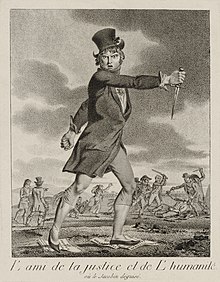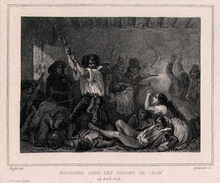TheWhite Terror(French:Terreur Blanche) was a period during theFrench Revolutionin 1795 when a wave of violent attacks swept across much of France. The victims of this violence were people identified as being associated with theReign of Terror– followers ofRobespierreandMarat,and members of localJacobin clubs.The violence was perpetrated primarily by those whose relatives or associates had been victims of the Great Terror, or whose lives and livelihoods had been threatened by the government and its supporters before theThermidorean Reaction.Principally, these were, in Paris, theMuscadins,and in the countryside, monarchists, supporters of theGirondins,those who opposed theCivil Constitution of the Clergyand those otherwise hostile to the Jacobin political agenda.[1]


The Great Terror had been largely an organised political programme, based on laws such as theLaw of 22 Prairial,and enacted through official institutions such as theRevolutionary Tribunal,but the White Terror was essentially a series of uncoordinated attacks by local activists who shared common perspectives but no central organization.[2]In particular locations, there were, however, more organized counter-revolutionary movements, such as theCompanions of JehuinLyonand the Companions of the Sun inProvence.The name 'White Terror' derives from the whitecockadesworn in the hats of royalists.[3]
Background
editThe Reign of Terror ended on 9 Thermidor Year II (27 July 1794) when Robespierre and his associates were overthrown.[4]However, there was not an immediate reaction to his rule, and for many months, an unstable political climate prevailed before a new order emerged. In Paris, there were increasing attacks onsans-culottesby Muscadins, and there were attacks on Jacobins inLyonandNimesin February 1795. However, only when a number of conditions changed did anti-Jacobin forces feel sufficiently confident to escalate these attacks into a full-scale White Terror.[5]
Politically, the Thermidorean Reaction did not remove from power all those who had been involved in the Reign of Terror – indeed, some of the most feared terrorists, includingJean-Baptiste CarrierandJoseph Fouchéhad been involved in overthrowing Robespierre, largely because they feared him calling them to account.[6]It took a period of several months before all of the leading figures associated with the Reign of Terror were brought to trial or removed from power.
Economically, there were food shortages as a result of a hard winter in 1794–5, and theassignatcurrency collapsed. The harvest of 1794 was poor, particularly in the areas which supplied Paris, and in many northern areas, people were reduced to consuming seed during the winter. Further south, rivers remained iced over and roads remained impassable in the spring, hindering trade and raising local prices.[7]The assignat fell from 31% of its face value in August 1794 to 24% in November, 17% in February, and 8% in April 1795.[8]In Paris, hunger and desperation led to theGerminal uprising of April 1795.[9]
Militarily, theNational Conventionwas fighting theChouannerierebellion in western France until December 1794.[10]TheTreaty of La Jaunayewhich ended the rebellion allowed the return ofnon-juring priests.[11]The agreement ended the direct military emergency facing the Republic and weakened the standing of theCivil Constitution of the Clergy.
Timeline of events leading to the White Terror
edit(source)[12]
- 1 August 1794 – Arrest ofFouquier-Tinville.The Convention repeals theLaw of 22 Prairial[13]
- 3 September 1794 – Arrest ofJean-Baptiste Carrier
- 8 September 1794 – The Revolutionary Tribunal begins to hear the case of the 94 Nantes Federalists. The accused made a very powerful appeal to public opinion by recounting in horrific detail the Terror in their city under Carrier. This trial was critical in hardening public opinion against the Jacobins.
- 16 October – The Convention bans any correspondence and affiliations between clubs, effectively outlawing the nationwide network of Jacobin clubs.[14]
- 17 October 1794 – The trial of the 94 Nantais ends with their acquittal and new accusations are brought against Carrier.
- 12 November 1794 – Following attacks by Muscadins who stone men and whip women, the Jacobin Club is closed by the Committee of General Security because it was a focus on violence
- 8 December 1794 – The Convention invites Girondin deputies excluded since 3 June to take their places again
- 16 December 1794 – Jean-Baptiste Carrier executed
- 7 February 1795 – The arrest of noted radicalGracchus Babeuf
- 8 February 1795 – The Convention decides Marat's remains are to be removed from the Pantheon
- 2 March 1795 – The Convention decrees the arrest of JacobinBarère,Billaud-Varenne,Vadier,andCollot d'Herbois
- 1–2 April 1795 – Germinal uprising of sans-culottes in Paris against hunger and reaction, rapidly suppressed. The Convention imposes martial law in Paris and decides that the arrested Jacobins Barère, Billaud-Varenne, Vadier and Collot-d'Herbois should be deported to Guyana without a trial.[13]
- 5 April 1795 – the Convention issues arrest warrants for a number of left-wing deputies, includingCambon,Levasseur de la Sarthe,Thuriot,andLecointre.[15]
- 6 April 1795 – The Convention reduces the power of the Revolutionary Tribunal
- 10 April 1795 – The Convention passes a decree ordering the disarming of everyone involved in the Reign of Terror
- 7 May 1795 – Fouquier-Tinville guillotined together with other associated with the Revolutionary Tribunal: Lanne (judge); Renaudin (juror), Leroy (juror), Foucault (judge); Vilate (juror); Scellier (Vice-chairman of the Revolutionary Court), Garnier-Launay (judge); Prieur (juror), Chatelet (juror), Girard (juror); Boyaval; Trey; Verney, and Dupaumier.[13]
Timeline of events in the White Terror
edit(source)[12]
- August–October 1794 – Newly freed press allows right-wing papers in Paris to call for revenge on the Jacobins, gave instructions for action and pointed out prominent Terrorist targets. In the provinces, Thermidoreanreprésentants en missionopened the prisons and stirred up calls for revenge on Jacobins – Boisset at Bourg, Goupilleau at Avignon and Auguis and Serre at Marseilles. They broke up local Jacobin committees and imprisoned many associated with them.[16]
- 2 February 1795 – Massacre of Jacobin prisoners atLyon.[17]On 14 FebruaryJoseph Fernex,a judge on the former Revolutionary Committee, in prison since Thermidor, is killed and thrown into the Rhône by a mob.[18]On 1 March another member of the Revolutionary Committee, Sautemouche, is killed.[19]Later in February Jacobin prisoners inNimesare killed.[17]
- 30 March 1795 – In Lyon, the threat of a massacre of prisoners and other Jacobins is now so great that Boisset orders detainees to be taken away toRoanneandMâcon[20]Nevertheless, on 4 April several thousand rioters break into three jails in the city and kill 99 Jacobin prisoners.
- 7 April – AtSt Etienne,the former Jacobin mayor Johannot is killed.
- 19 April 1795 – AtLons le Saunier,six Jacobins who had been arrested and were being taken into the town are killed on the road.
- 11 May – AtAix en Provencethirty Jacobin prisoners are killed. InNîmes,Jean-Antoine Courbisis killed.[21]
- 20 May 1795 –Prairial uprisingof sans-culottes in Paris put down by the army.
- 23 May 1795 – Military Commission to judge Prairial insurgents established. It disarms the sections and pronounces 36 death sentences. Around 1,200 people are imprisoned in Paris, and tens of thousands more in the provinces.[22]
- 25 May – A number of Jacobin prisoners atTarasconare killed
- 2 June – Twelve Jacobin prisoners killed at St Etienne
- 5 June – At Marseilles, 700 Jacobin prisoners are massacred in the prison of Saint-Jean fort.
- 27 June – Members of the former Revolutionary Tribunal atOrangeare killed and thrown into the Rhône.[23]
Effects in other towns
editThe White Terror spread throughout the country, with some regions claiming not to have beendisgracedby the Reign of Terror and others believing that there had to be significant retributions. Individuals accused as terrorists were then put on trial and executed. Overall, the severity of the reactions to the Reign of Terror was dependent on how each region was involved in the Revolution and on that region's specific history. Lists of those persecuted, as well as existing judicial and police records, indicate that a strong majority of accusations made did not arise from actions during the Reign of Terror at all but rather from personal or regional grudges.[24]
- In the department ofPyrenees-Orientales,records state that after Thermidor, there were no terrorists residing there. They boasted of not having been "disgraced" by either theTerroror the Reaction.
- In the small village ofVellerontheVaucluse,with a population of about 900 people, quite a few of its citizens had been wrongfully convicted and executed in theReign of Terror.Many of the people who brought these charges were their fellow citizens. Many of the accused were eventually persecuted or sent to the guillotine. After theReign of Terror,from 1796 to 1797, the families that had been the victims of these arrests led a "reaction" against the accusers of theReign of Terror.The most common methods of persecution against the accused during the White Terror were either arson or murder. Judicial records indicate about 9 convictions of individuals alongside their families.[24]
- In the 8,000 person community ofAubagnethere was a large local impact from the Reign of Terror. Primarily from 1795 to 1797, there was a phase of prolonged violence. The town had a large number of revolutionaries, as well as a long history of factional conflict. From 1795 to 1797, the years that are considered the town's "Reaction" to theReign of Terror,413 people were imprisoned and eventually executed. Judicial records indicate that the accusations and deaths during the Reign of Terror and the White Terror both followed historical familial struggles and traditional regional struggle patterns.
See also
editCitations
edit- ^Denis Woronoff, The Thermidorean regime and the Directory, CUP (1972), p. 23.
- ^Alfred Cobban, A History of Modern France vol 1 1715–1799 Penguin (1957), p. 243.
- ^John Paxton, Companion to the French Revolution, Facts on File Publications (1988), p. 207.
- ^John Paxton, Companion to the French Revolution, Facts on File Publications (1988), p. 186.
- ^The Thermidorian regime and the Directory 1794–1799, CUP (1972), p. 23.
- ^David Andress, The Terror: The Merciless War for Freedom in Revolutionary France, Farrar, Straus, and Giroux, (2005), p. 237.
- ^The Thermidorian regime and the Directory 1794–1799, CUP (1972), p. 11.
- ^The Thermidorian regime and the Directory 1794–1799, CUP (1972), p. 10.
- ^Godineau, Dominique. "14. Firebrands, April-May 1795".The Women of Paris and Their French Revolution,Berkeley: University of California Press, 1998, pp. 316-330.
- ^John Paxton, Companion to the French Revolution, Facts on File Publications (1988), p. 50.
- ^David Andress, The Terror: The Merciless War for Freedom in Revolutionary France, Farrar, Straus, and Giroux (2005), p. 354.
- ^abDenis Woronoff, The Thermidorean regime and the Directory 1794–1799 CUP (1972), pp. ix-x.
- ^abcChronicle of the French Revolution, Longman (1989), p. 474.
- ^Chronicle of the French Revolution, Longman (1989) p. 454.
- ^Chronicle of the French Revolution, Longman (1989), p. 473.
- ^Denis Woronoff, The Thermidorean regime and the Directory 1794–1799, p. 5.
- ^abDenis Woronoff, The Thermidorean regime and the Directory 1794–1799, p. 23.
- ^Chronicle of the French Revolution, Longman (1989), p. 468.
- ^Chronicle of the French Revolution, Longman (1989), p. 470.
- ^Chronicle of the French Revolution Longman (1989), p. 476.
- ^M A Kennedy; Michael L Kennedy (2000).The Jacobin Clubs in the French Revolution, 1793–1795.Berghahn Books. p. 249.ISBN978-1-57181-186-8.
- ^Denis Woronoff, The Thermidorean regime and the Directory 1794–1799, p. 19.
- ^Chronicle of the French Revolution Longman (1989), p. 484.
- ^abMcPhee, P. (2012) The White Terror, in A Companion to the French Revolution, Blackwell Publishing Ltd, Oxford. doi: 10.1002/9781118316399.ch22http://onlinelibrary.wiley /doi/10.1002/9781118316399.ch22/summary